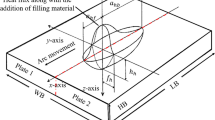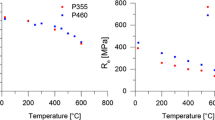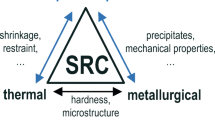Abstract
The RESIST (Residual Stress and Structural Integrity Studies using Thermography) project aims to develop a non-contact, non-destructive, full-field measurement and portable residual stress assessment technique based on thermoelastic stress analysis (TSA). The TSA residual stress assessment (RSA) technique relies upon a change in the thermal expansion coefficient when a material is subjected to plastic straining. TSA RSA has been successfully applied to non-welded materials, so the next stage is to assess the feasibility of application on weldments. The study focuses on establishing the validation of the technique on austenitic stainless steel AISI 316 L (EN 1.4404), which is commonly used in power generation industry. A series of increasingly complex ‘weld mock-ups’ made out of 316 L are designed to test the TSA RSA approach. Finite element (FE) simulations of the welded mock-ups were produced. The design, FE modelling and manufacture of two of the mock-ups are presented. The expected amount of plastic strain is compared with the TSA assessment in another part of the RESIST project, and thus, informs the validation of the technique on weldments.
Access provided by CONRICYT-eBooks. Download conference paper PDF
Similar content being viewed by others
Keywords
9.1 Introduction
The RESIST project aims to develop a non-contact, non-destructive, full-field measurement and portable residual stress assessment technique based on TSA [1]. TSA is an experimentally based technique in which the change in temperature of a material or component subject to a cyclic load, ΔT, is related to the change in the sum of the principal stresses \( \varDelta \left({\sigma}_1+{\sigma}_2\right) \), as follows:
where T is the temperature of the surface of the component and K is the thermoelastic constant, which is a material parameter defined as \( K=\alpha /\rho {C}_p \); α is the coefficient of thermal expansion, ρ is the material density and C p is the specific heat at constant pressure.
The TSA RSA technique relies upon the change of the thermoelastic constant K of the material, which occurs after a material has been subjected to plastic straining [2]. An infra-red detector measures T and ΔT of a component under a linear elastic cyclic loading. If K changes then ΔT will change, making it possible to identify areas that have been subject to plastic straining. If the change in K can be quantified then the amount plastic straining experienced can also be obtained. Since weld residual stresses are initiated by plastic deformation, the residual stresses could be derived from the amount of plastic strain experienced. The regions that have experienced plastic straining have been identified in non-welded materials [3], however, the next stage is to assess the feasibility of application on weldments.
9.2 Methodology
To validate the TSA RSA technique, a series of weld mock-ups are designed and assessed using FE analysis. The geometry and welding method are investigated so that distortion is avoided, which may affect the thermoelastic response. Preliminary FE model of the mock-ups are produced to determine if enough plastic strain is generated during the welding process to provide a measurable change in the thermoelastic response. To calibrate the models thermocouples are used during the welding process to measure the heat generation and centre hole drilling (CHD) and X-ray diffraction residual stress measurements are made after the welding and manufacturing processes. The FE models are created and calibrated using both fusion line and temperature matching. Validation of the models against the experimental residual stress measurements is then performed. The residual stress and plastic strain are extracted for comparison with TSA RSA results.
The first step in the process is to design a welded component that contains a sufficient amount of plastic strain to produce a detectable change in the thermoelastic response. It was therefore decided to adopt an approach used in industry and create a ‘mock-up’. Mock-ups are used in industry for the validation of FE models, when it is not possible to obtain measurements from the actual structure (e.g. in the nuclear industry). The structure or a part of the structure is manufactured, at the same dimension or at a different scale and measurements are performed on the mock-up, e.g. to give information to calibrate and validate the FE model. Once the FE model is validated, it can be used to predict distortion, stresses, fatigue resistance etc.
It is envisaged that a number of mock-ups that contain increasing complexity in terms of specimen and weld geometry will be made. The overall design criteria for the mock-ups are as follows:
-
1.
to contain a weld in which all welding parameters are known so that the plastic straining and the residual stresses can be modelled accurately,
-
2.
the mock-up must be designed to be cyclically loaded in a servo-hydraulic test machine with the weld positioned so it has a clear line of sight to the infra-red camera to enable images to be captured for the purpose of TSA.
The aim is to define a procedure to assess the potential of using TSA for residual stress assessment using mock-ups. The proposed procedure is shown schematically in Fig. 9.1. A mock-up is defined. Any welding and machining procedures are modelled using FE modelling and the plastic strain and residual stress fields are predicted. The thermoelastic response \( {\frac{\Delta T}{T}}_{TSA} \) of the mock up is obtained. A linear elastic finite element (LEFE) model of the loaded mock-up (i.e. the effects of welding are not modelled) is created and the calculated thermoelastic response \( {\frac{\Delta T}{T}}_{LEFE} \) subtracted from the experimental thermoelastic response to obtain the influence of weld induced plastic strain on the thermoelastic response. The influence of the plastic strain on the thermoelastic response is then compared with the predicted plastic strain and residual stress field prediction to define the TSA response of a welded component.
9.3 Illustration Case: Mock-Up A
Mock-up A is a strip of material with a welded section at the centre as presented in Fig. 9.2. It is essentially a slice through a weld, where the weld penetration in the base material can be imaged. The proposed imaged region is delimited in green on Fig. 9.2 which is a zoom-in on the weld.
To create Mock-up A, a 316 L stainless steel 321 × 270 × 15 mm plate had a weldment deposited on both side simultaneously to create a ‘bead-on-plate’ specimen. The welding process was manual metal arc (MMA) welding with a heat input of 2310 W at a welding speed of 3.7 mm/s and the deposited weldment material is 308 stainless steel. To monitor the temperatures developed in the welding process eight thermocouples were attached on both sides of the plate. After complete cooling of the plate, residual stress measurements were calculated from centre hole drilling (CHD) measurements. The positions of the thermocouples and CHD are presented in Fig. 9.3 and were taken on both sides of the plate, away from the middle of the plate, not to impede with cutting of the mock-up. The double bead-on-plate specimen was subsequently cut using electrical discharge machining (EDM) to create three 7 mm thick slices, i.e. the mock-up in the direction transverse to the weld so the weld could be imaged with TSA.
The FE analysis software Abaqus was used to create the model of Mock-up A. The dimensions of the plate depicted in Fig. 9.3 were used to create the geometry of the bead-on-plate model. Material properties from [4] were used to model the thermal and mechanical behaviour of the parent material. The mesh of the FE model is presented in Fig. 9.4. Tetrahedral elements of 2 mm3 were used to map the weld and heat affected zone (HAZ). The mesh is fine in the region of the weld and around the slices to remove, and coarser elsewhere.
To model the heat source, a double ellipsoidal moving heat source model, developed by Goldak [5], was used to simulate the deposition of the double bead-on-plate. The efficiency and geometrical parameters of the double ellipsoid were calibrated against two of the thermocouples measurements, at 10 mm and 15 mm away from the weld bead. Satisfactory comparison between thermocouples and the fusion lines were obtained as it can be seen respectively in Figs. 9.5 and 9.6. The mechanical boundary conditions during the welding process were modelled by setting displacement to zero on the two red lines in Fig. 9.4.
A total of eight locations of centre hole drilling measurements were compared with the predicted residual stresses and the results were satisfactory for half of them. To simulate the cutting of the plate, small elements (1 mm3) were removed around the slice. The resulting slice represents one of the Mock-up A specimens, and the plastic strain magnitude was predicted as it can be seen in Fig. 9.7.
9.4 Results and Discussion
Mock-up A, the first weldment designed for TSA was presented. It was manufactured from a 316 L bead-on-plate welded on both side and subsequently cut in the direction transverse to the weld, to produce a 7 mm slice, Mock-up A. The FE model of Mock-up A was created and good calibration of the heat source was obtained. The validation of the stress prediction against eight CHD measurements was satisfactory for 50 % of them. The difficulty in validating the residual stress prediction can be attributed to the manual aspect of the welding process, which involves many unknowns that cannot be taken into account in the modelling. Some of the CHD measurements values can be impacted by the large stress gradient in the HAZ as it is recommended CHD should indeed be located in regions of small stress gradients [6].
When the mock-up was created, EDM cutting process was selected to cut the slices as this technique is commonly used in the contour technique, where no residual stress or plastic strain should be induced [7]. Therefore the first approach to model this cutting was to remove a thin slice of elements, to release residual stresses normal to the cutting direction. Nonetheless EDM cutting modelling was investigated in further details and it was found that EDM introduces residual stress and plastic strain in the very near surface (typically a few tens of microns) called the “recast layer” [8]. TSA was applied on the cutting surface, so, if polishing does not remove the whole thickness of recast layer, results will be influenced by plastic strain induced by EDM cutting. The FE modelling of EDM is computationally difficult so it was decided that the next mock-ups will not be imaged on a surface resulting from an EDM cut.
9.5 Conclusions and Future Work
In Mock-up A one of the major difficulties was the uncertainties produced by the EDM cutting of the mock-ups from the large bead-on-plate specimen, particularly in predicting the residual stress relaxation during the cutting. It was therefore decided that Mock-up B should be such that the cutting stage is eliminated. A further consideration was controlling the shape and size of the weld bead in Mock-up A so Mock-up B contains a double autogenous weld, meaning that no bead is created, so it is not necessary to include the filler metal or the bead geometry in the model. It has been decided to use the TIG welding process for the autogenous weld using and automated process with the electrodes fixed to a support at a set distance from the plate, which will move across the welding torches. In this way the weld trajectory and the welding speed are controlled, unlike in Mock-up A which relied on the two welders.
References
Dulieu-Barton, J.M.: Thermoelastic stress analysis. In: Rastogi, P., Hack, E. (eds.) Optical Methods for Solid Mechanics. Wiley, Weinheim (2012)
Quinn, S., Dulieu-Barton, J.M., Langlands, J.M.: Progress in thermoelastic residual stress measurement. Strain 40, 127–133 (2004)
Robinson, A.F., Dulieu-Barton, J.M., Quinn, S., Burguete, R.L.: The potential for assessing residual stress using thermoelastic stress analysis: a study of cold expanded holes. Exp. Mech. 53, 299–317 (2013)
Bate, S.K., Charles, R., Warren, A.: Finite element analysis of a single bead-on-plate specimen using SYSWELD. Int. J. Press. Vessel. Pip. 86, 73–78 (2009)
Goldak, J., Chakravarti, A., Bibby, M.: A new finite element model for welding heat sources. Metall. Mater. Trans. B 15(2), 299–305 (1984)
Scaramangas, A.A., Porter Goff, R.F.D., Legatt, R.H.: On the correction of residual stress measurements obtained using the centre-hole-drilling method. Strain 18(3), 88–97 (1982)
Hosseinzadeh, F., Kowal, J., Bouchard, P.J.: Towards good practice guidelines for the contour method of residual stress measurements. J. Eng (2014)
Cheng, W., Finnie, I., Gernaud, M., Prime, M.B.: Measurement of near surface residual stress using electric discharge wire machining. J. Eng. Mater. Technol. 116(1), 1–7 (1994)
Author information
Authors and Affiliations
Corresponding author
Editor information
Editors and Affiliations
Rights and permissions
Copyright information
© 2017 The Society for Experimental Mechanics, Inc.
About this paper
Cite this paper
Chevallier, E.C., Blackwell, S., Dulieu-Barton, J.M. (2017). Finite Element Modelling of a Series of Austenitic Stainless Steel 316 L Weldments to Inform Thermoelastic Stress Analysis Residual Stress Assessment. In: Quinn, S., Balandraud, X. (eds) Residual Stress, Thermomechanics & Infrared Imaging, Hybrid Techniques and Inverse Problems, Volume 9. Conference Proceedings of the Society for Experimental Mechanics Series. Springer, Cham. https://doi.org/10.1007/978-3-319-42255-8_9
Download citation
DOI: https://doi.org/10.1007/978-3-319-42255-8_9
Published:
Publisher Name: Springer, Cham
Print ISBN: 978-3-319-42254-1
Online ISBN: 978-3-319-42255-8
eBook Packages: EngineeringEngineering (R0)











